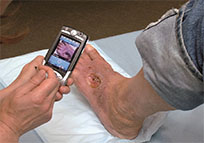 Around 3,000 Danes become affected by diabetic foot ulcers every year. Treating the disease is deemed to incur costs in the order of 900 million DKK annually. Occasionally, the tissue in parts of the foot cannot survive and the only solution is to amputate the affected part. In such cases, the costs according to Swedish data may amount to approx. 400,000-600,000 DKK.
Around 3,000 Danes become affected by diabetic foot ulcers every year. Treating the disease is deemed to incur costs in the order of 900 million DKK annually. Occasionally, the tissue in parts of the foot cannot survive and the only solution is to amputate the affected part. In such cases, the costs according to Swedish data may amount to approx. 400,000-600,000 DKK.
Diabetic foot ulcers are very complex conditions where damages to neighbouring nerves or vasculars as well as infections may have a significant adverse effect on the development of the disease. This means that the risk of complications and even death is increased. Consequently, there is a great need for technologies that can describe diabetic foot ulcers in a better and broader context.
The Vision
In the project, "Diabetic foot ulcers", Patient@home focuses on the issue mentioned above by exploring new sensor technologies that in the early stages of the disease can give health professionals more accurate tools to grade and characterise diabetic foot ulcers - and thus enabling more targeted treatment efforts.
More specifically, the project initiates the development of sensors for measuring temperature, pH values, oxygenation, secretions, edema, and markers of biofilm formation in diabetic foot ulcers. The development of these sensors is based on and combined with an already developed prototype of a handheld 3D optical wound scanner which can be operated by a wound care nurse in the patient's own home.
The project results are expected to lead to a more detailed understanding of the factors that affect the healing processes in diabetic foot ulcers and other complex wounds. In addition, the use of telemedicine-based wound scanners and wound-care databases will enable patients and health care professionals to take and send digital photos to selected physicians - particularly in terms of suggested treatments or required attendance. In addition, a web-based solution will enable patients to contact their physicians in several ways without having to turn up at the physicians' premises for con. For instance, the use of a sock fitted with temperature sensors may enable continuous temperature measurements with patients suffering from severe neuritis and collapse of the bone structure of the foot - which will be indicative of the level of activity that the individual patient will have to deal with.
The project is combined with another Patient@home project, "Monitoring of cardiac patients", that is engaged in developing and testing intelligent patches for cardiac rhythm monitoring. The goal here is to monitor the heart rate variability with patients suffering from diabetic foot ulcers.
5 mini projects
The project also aims to explore, in 5 mini projects, how to monitor, stratify, and help these patients suffering from diabetic foot ulcers.
These five projects include:
- Project 1: On-Foot Enclosure
- Project 2: Ulcer Camera Monitoring
- Project 3: MIB: Multisensor Intelligent Bandage
- Project 4: Patient Remote Camera
- Project 5: Sore Score